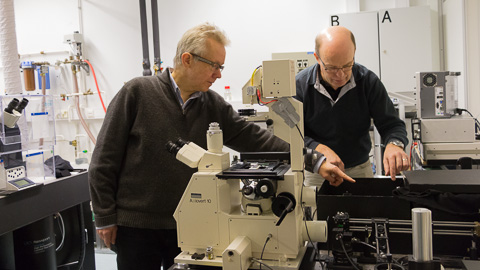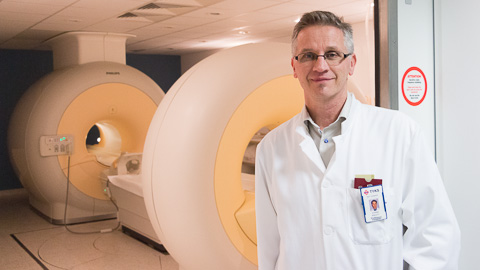Co-operation between Universities Revolutionised the Research of Biosciences
Stefan Hell received support for his Nobel prize-winning research from Turku, where the research on biosciences was taken to the next level thanks to co-operation between the universities.

John Eriksson and Pekka Hänninen are presenting an optoacoustic microscope in the same laboratory where Stefan Hell tested his idea in the early 1990s.
Next week, Stefan Hell will receive the Nobel Prize in Chemistry for his research which has its roots at the University of Turku. Hell tested the principles of super resolution microscopy in the Laboratory of Biophysics at the University of Turku, on the fifth floor of the Biocity building.
Now, Professor of Medical Physics and Engineering Pekka Hänninen from the University of Turku and Professor John Eriksson from the Department of Biosciences at Åbo Akademi University sit on the fifth floor and demonstrate Hell’s observation on fluorescence. It is the utilisation of the quantum characteristics of fluorescence that made it possible to improve the resolution of optical microscopy.
When Hänninen points a green light into a sample bottle containing rhodamine dye, the light turns orange. A bottle of cola on the table is more fluorescent than coffee where the green light disappears almost completely. Nevertheless, nearly all coloured materials and liquids are fluorescent. In super resolution imaging, molecules are detected from the biological sample from the area of interest with fluorescence and the image forms pixel by pixel on the computer screen.
– Hell’s research was definitely one of the pioneering ones at the newly-constructed BioCity. At that time, the development of microscopy had a significant role, says Hänninen.
Research on Cell Signalling Involves the Fundamental Questions of Life
Hell arrived in Turku at an opportune moment as Turku Centre for Biotechnology had just moved to the new facilities in BioCity only a year earlier in 1992. Before the joint facilities, the researchers of different disciplines worked alone and were often not even aware of what was happening in the next room. When BioCity was completed, the universities started using shared equipment and conducting more research together, which significantly improved Turku’s position in the biosciences research.
One discipline that has benefitted from the universities’ co-operation is the research of cell signalling which is conducted in both universities. The cells in our bodies signal each other all the time, but it is enough for the creation of cancer, for example, that just one message goes awry.
– Cancer cells are created in our bodies all the time and the cells of the immune system usually destroy them. However, sometimes the cancer cell survives the attack and becomes stronger. In tracking the origins of cancer, the biggest steps have been taken in the study of signalling molecules where researchers have found signals which they can influence, says Eriksson.
According to Eriksson, the research of cell signalling is vitally important as all the central processes of life are defined through cell signalling. The cells constantly signal each other about the basic necessities, such as survival, movement and nutrition.
According to Juhani Knuuti, the western lifestyle, where the quality and quantity of nutrition and energy do not meet the body’s needs, factors into the increase in cardiovascular diseases. However, young adults do not suffer from coronary artery disease, unlike in the 80s.
Research Extends from the Molecule to the Patient
”From atoms to anatomy” is the motto that describes the research of the Turku Bioimaging network. It means that within the organisation researchers can study both the molecule that causes the disease and the patient who has it – and several stages between the two. The Turku Bioimaging network coordinates the bioimaging work, education and procurement of equipment in the universities as well as in Turku University Hospital.
– In case of the molecules that cause diseases, researchers study, for example, how the disease could be cured with therapy or medicine. The researchers try to change the interaction between molecules with stem cell treatments, immunotherapy or drug trials, says Eriksson.
The hypotheses developed in molecular research can be tested first with simple cell models and then with animals. In best case scenario, the treatment proceeds all the way to the patients in need of treatment.
– In Turku, the diagnostics is world class and diagnostics methods are included in the research in the very early stages. When we find a mechanism that is crucial to a certain disease, we can also find the mechanism for preventing it. However, this usually takes time and the small findings amount to a complete picture in the course of years, says Hänninen.
Text and photos: Jenni Valta
Photo on the front page: skeeze
Translation: Mari Ratia